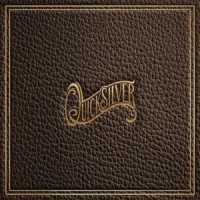
Quicksilver
Overview
Quicksilver is a competitive race game where you must pilot your own “Quicksilver” craft over a vast landscape, rounding a series of checkpoints and being the first to the finish line. But so much can happen along the way. Each turn Tactics cards played from other players may blow your craft off course (or blow your craft up!). Airship to Airship combat is frequent and deadly. Then there are the potential hazards (both natural and otherwise) to consider: mountain ranges, clouds, turrets and minefields. Use your own instrument panel and Tactics cards to shape your strategy each turn to hit each checkpoint and cross the finish line to emerge victorious.
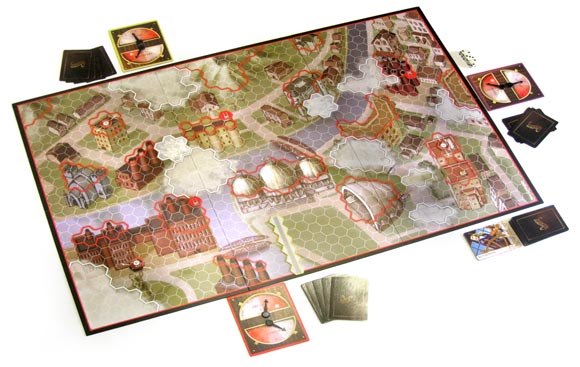
Set Up
After the game board is selected and laid out, (there are two sides: Paradise Falls: Easy, and New Covington: Difficult)) each racer selects an Airship token, and its matching Instrument Panel. On the panel, Velocity is set to 0, and the Armor is set to 4. Shuffle the deck of Tactic cards and deal 5 to each participant. Then the parameters for the race are discussed and agreed upon: location of the start/finish line, number of checkpoints, and so forth. (There are suggestions for first time racers).
Each racer then chooses and places an Obstacle token on the game map, (Clouds, Turrets and Mines) following the specific rules for their placement. One Turn Order card is then dealt randomly to each racer. The racer with the image of Queen Victoria is the starting player for the race. Then each racer, in reverse player order, places their airship on or behind the starting line. The race begins!
Gameplay
Quicksilver is played in a series of turns where you must complete all the actions for your turn before play passes to the next player clockwise. Each racer’s turn is made up of 5 Phases:
1. Velocity
The racer may raise or lower their Velocity if they wish. The higher the Velocity, the more Velocity dice you will roll and the farther your Quicksilver airship will move. However the maximum Velocity is 3 and when moving at that speed, a racer must discard two Tactics cards during their Move phase.
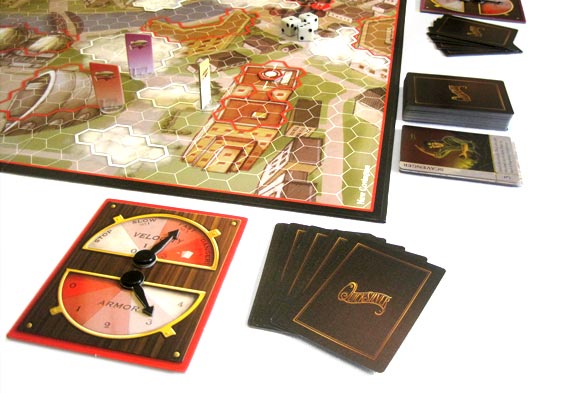
2. Roll
The racer rolls dice equal to their Velocity and the result is that players number of Movement points. Each Velocity level has a minimum speed which will be the least a racer can move no matter the roll. In addition, a racer may discard one Tactics card from their hand to add or subtract its point value from the roll. This represents the subtle adjustments that can be made when piloting. But only one card can be used in this manner. If a racer’s airship begins its movement within a white-bordered area, the movement total is reduced by one-half, rounding up. The resulting number is the total number of movement points a racer will have in their turn.
3. Pivot
Quite simply, a racer has one chance to pivot their airship and it’s before they move their Quicksilver. (Although some Tactics cards may break this rule). A racer may pivot 60 degrees (one hex side) without effect. The racer may also pivot their airship 120 degrees, but must take 1 point of damage to their armor. Airships cannot turn 180 degrees in a single turn.
4. Move
Racers now move their airship forward in a straight line one hex for each remaining movement point. Racers move as far as they can until they run out of movement points, collide with a mountain, checkpoint, or the boundary of the game board.
5. Draw
A racer now draw one Tactics card. If they have more than 5 cards in hand, they must discard down to 5 cards. Dice are passed to the player on the left and the game continues.
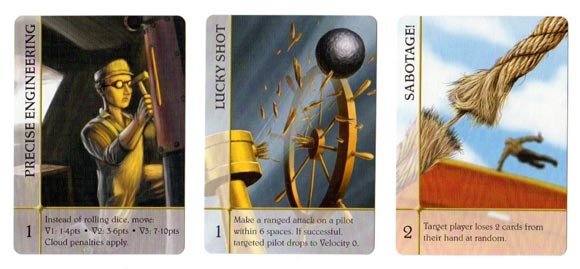
Playing cards
How and when to play Tactics cards can mean the difference between winning or crashing and burning. All cards have two possible uses:
- Tactical Effect: At any time during their turn, a racer may play any number of Tactics cards for their effect. Some cards that cancel opponents’ effects can be played on another racer’s turn. A racer can only make one successful attack per opponent per turn.
- Point Value: Each card also has a point value. As was already mentioned, only one card can be played to affect movement after the Velocity dice have been rolled. But any number of Tactics cards can also be played for their value to affect the results of Attack die rolls. So let’s talk about Attacks!
Attacks
Any action a racer takes that interferes with an opponent is considered an attack. This includes playing Tactics cards, and colliding with opponent’s airships. In both cases both player roll two dice. Any number of Tactics cards may be played and discarded to add to the value, The racer with the highest value after all cards have been played wins the attack. Ties go to the racer who initiated the attack. The racer with the lower total reduces the Armor of their airship by 1 point.
If a racer’s Quicksilver passes through an opposing racer’s hex during movement, the moving player has the choice to collide with his opponent or discard one card to pass through without incident. If not, the procedure above is followed, the losing racer absorbs the collision, reduces their armor and the moving player continues their turn.
Checkpoints
Successfully navigating checkpoints is more difficult than it looks. Movement must be planned, attacks avoided and the racer’s airship must go around the check point in the proper direction crossing the plane of both entry and exit points for that checkpoint. The first racer to cross a checkpoint causes all other racers to immediately draw Tactics cards up to their starting hands.
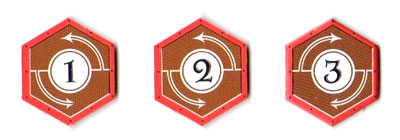
Winning and losing
In the base game, the first racer to cross the finish line wins! So, in the base game, the only way to lose is to not cross the finish line first. If a racer’s armor is reduced to 0 at any time they simply lose a turn, restore one point of armor and then start the race again on their next turn. But game variants can make the game much more lethal.
Components
With a slightly steam punk feel and a classy presentation, the art and graphics of the game are good. One does pine for some detailed airship minis. The Instrument panels, card art and game board do well to create that “wind in your hair” feeling an airship race should have. But the components are not the main attraction. The game doesn’t greedily try to grab your attention the way many over produced over illustrated games do. Case in point: the game box cover. It’s a refreshing change to the “in-your-face” marketing of many other game boxes. It almost beckons you to open the box and play.
Learning Curve
Low: Its very easy to learn the game phases. The game can be taught in minutes.
Who would enjoy this game?
Final Thoughts
Race games are as old (if not older) than the hills. From Senet to Mancala, Backgammon to the Royal Game of Goose, Circus Maximus to Formula D. Each offers that core experience of the challenge of “getting there first.” There is not a single person on the planet that doesn’t get that concept, and that is what makes race games familiar and easy to jump into. That’s the positive. The negative aspect of most race games is that specific moment that may occur when a player realizes there is no way for them to win. The leader has just pulled too far ahead and the rules and mechanics, no matter how you work them, will not permit you to catch up. To remedy this, race games mitigate that negative by using “attacks.” In Backgammon and Sorry! you send a person’s token back to start and so forth. In this way the “last racer standing” concept can provide a more varied balanced and intense experience. Quicksilver tics all these boxes. You can run a “clean” race, out-thinking and out-maneuvering your opponents. Or you can focus on making sure your opponents don’t live to see the finish line. Usually a combination of both is most effective. Those are the commonalities. There are also some interesting features that set Quicksilver apart.
For the pure experience of racing, (all attacks aside) the theme and mechanics work together to give you the feeling of an airship race. You are, after all, piloting an airship, not a chariot or a formula one racer. And one would imagine that you just wouldn’t be able to control an airship like one of these other crafts. They would be more vulnerable, more susceptible to wind, and natural obstacles. When playing, you have a sense that you don’t truly have control. And that an airship is not specifically designed for safe and fast travel. The fact that you can only adjust your heading once (at the start of your move) and then plunge straight forward the total number of movement points, plays on that vulnerability. The first thing a race game should always be about is how you move. In this way Quicksilver succeeds in giving you a uniquely unnerving feeling.
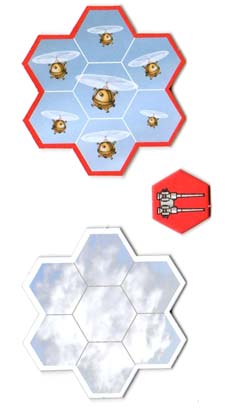
To mix things up a bit you have natural hazards like the Clouds and Mountains. Unnatural obstacles like Turrets, Mines and Checkpoints. (who is in those turrets anyway and why are they shooting at me?). And the two different game boards very much affect the level of difficulty. But the Tactics cards are the components that give you that feeling of control (if it’s your turn) and danger (if it’s another racer’s turn).
Of the 18 different Tactics cards, more than half of the cards are “positive” tactics. In other words, cards that help a racer pilot their own airship. “Side Step” allows a racer to shift one hex to the left or right during movement. “Emergency Stop” allows a racer to end their movement early. And so forth. Six of the cards are direct attacks on another racer. The “Lucky Shot” is successful reduces an opponent’s velocity to 0. The “Gust of Wind” might move an opposing racer’s airship one die roll in any direction. (Blam! Hello mountain side!). And there are a few cards that allow a racer to cancel a card played or re-roll dice. There are not many different cards, but those that are included are very effective.
The variants provided in the rules also offer a more intense experience, and in fact the game is much better with them; ramping up the intensity of the experience. “Blind Attack” has player place their Tactics cards to affect attack rolls face down. The “Elimination” variant well…eliminates a player if their armor drops to 0. Each of the five variants gives different player types a unique experience.
Quicksilver is not a race about speed, although the gameplay is speedy. The game does not recreate a breakneck race, although you might break your neck. What designer Paul Imboden offers is a thematic race experience. Imagine sailing quietly, your rotor blades humming, propelling your gas-filled craft. You are thousands of feet in the air, looking over mountain peaks, or Victorian factories while off in the distance, several airships (your opponents), are gaining. You’re at the mercy of the wind, and vulnerable to attack. A checkpoint is ahead and you will need to reduce your speed. The a cannon ball rips through your hull! If you can imagine this kind of race experience, then allow Quicksilver to transport you there. And remember to pack your moustache wax!
User Reviews (0)
Add a Review for "Quicksilver"
You must be logged in to add a review.

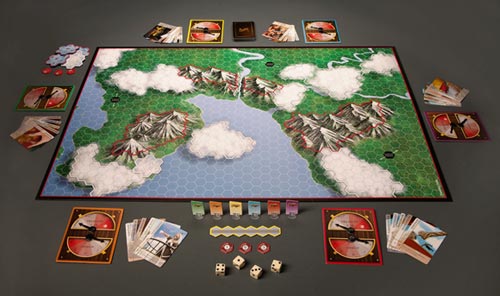
Be the First to Add a Review!